The Berkshires Bowling Alley that Inspired "The Big Lebowski"
It’s been 36 years since the release of The Big Lebowski, the irreverent cult comedy by Joel and Ethan


High above the pews, behind the balcony, at the very back of St. Augustine’s Episcopal Church, there exists a physical reminder of a time in American history that most churches have chosen to erase. Located at 290 Henry Street in Manhattan’s Lower East Side, St. Augustine’s is one of the few remaining churches in the country to retain its “slave galleries,” small, hidden rooms at the back of the church designed in the 1820’s as seating for enslaved African Americans. It was there that enslaved people were placed sit out of sight of the white congregation during church services.
Today, the church is calling attention to this spot and confronting its history – starting with an artistic light installation, how the Other 1/2 lived, by Denzel Russell that was on exhibit in November. The work was supported by the Abrons Art Center, a home for contemporary interdisciplinary arts in Manhattan’s Lower East Side neighborhood and a core program of the Henry Street Settlement.
Untapped Cities took a tour of the church to learn about the history of the galleries and how they have been restored and preserved by The St. Augustine’s Project. If you are an Untapped Cities Insider, you can join us for a special tour of St. Augustine’s Episcopal Church and the slave galleries on February 23rd. Not an Insider yet? Become a member today to gain access to free behind-the-scenes tours and special New York City events all year long!
[mepr-show if=”rule: 518547″][uc_booking_button title=’Book Now’][/mepr-show][mepr-hide if=”rule: 518545″][uc_insider_button title=’BECOME A MEMBER TO JOIN THIS TOUR FOR FREE!’ url=’/plans/insiders/’][/mepr-hide][mepr-show if=”rule: 518546″][uc_insider_button title=’UPGRADE YOUR MEMBERSHIP TO JOIN THIS TOUR FOR FREE!’ url=’/plans/insiders’][/mepr-show]
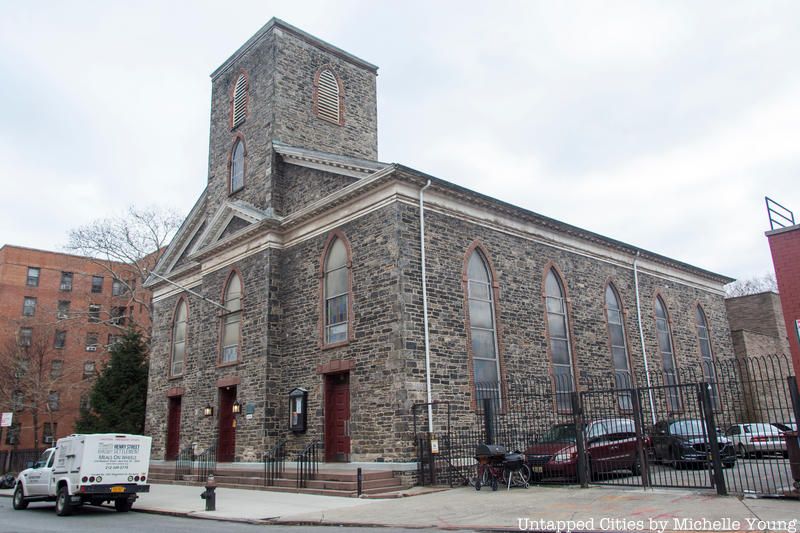
Accessible by a winding narrow wooden staircase at the back of the church, the two galleries, one for men and one for women, flank a 150-year-old Erben pipe organ, once the city’s oldest functioning organs. It was believed that the men were likely seated in the gallery next to the wheel (which still remains) that powered the organ and one of them would be assigned the job of turning it during the service. In the other gallery, shadow boxes deliberately retained by the church as a reminder of the original construction indicates where researchers believe there were once nursing benches which would have been used by women.
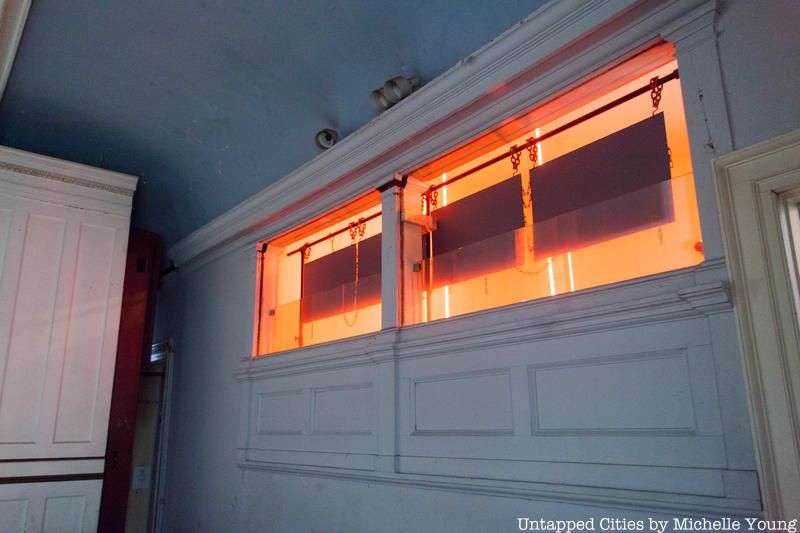
View of one of the slave galleries from the back of the sanctuary’s second floor
The slave galleries were by no means comfortable. There were no seats but rather bleacher style wooden benches. During the warmer months, the tiny enclosed space got very hot. In the winter months, with no heating, the space got very cold. At the front of the galleries there is a large opening through which those inside could look out onto the altar without being seen from below. The window was likely covered with either a burlap flap that would be rolled up or a latched door that would be held open with a hook. Those seated in the galleries were not permitted to participate in the service and were likely supervised. They were not to be seen or heard.
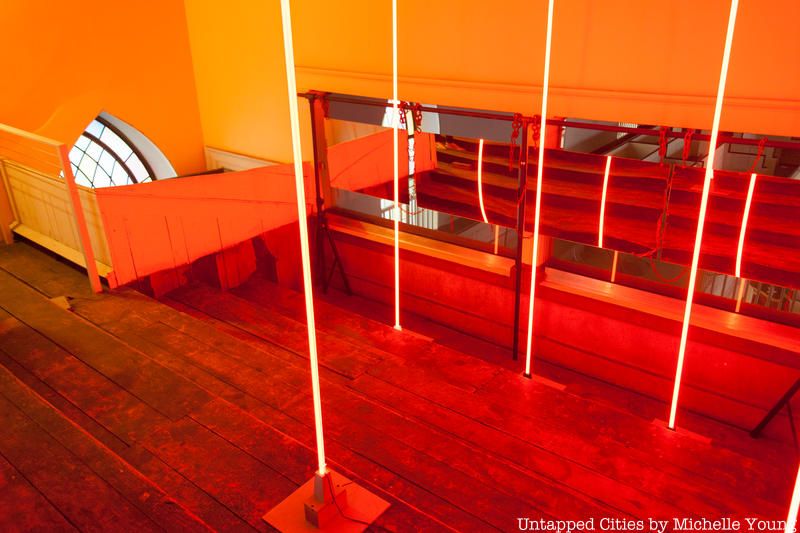
The art installation how the Other 1/2 lived, by Denzel Russell
At the time of the church’s opening in 1828 it was called the All Saints Free Church. In the 1940s as congregations dwindled, All Saints and St. Augustine’s, which was then located on Houston Street, merged. Early congregants of the church on Henry Street were mostly wealthy, white merchant seamen who owned ships and land and came from Brooklyn or New Jersey to worship. The slaves were likely rowed over to Manhattan by their slaves and promptly separated before even entering the church. White congregants likely entered through the middle doors while the slaves were escorted through side doors and led straight to the galleries.
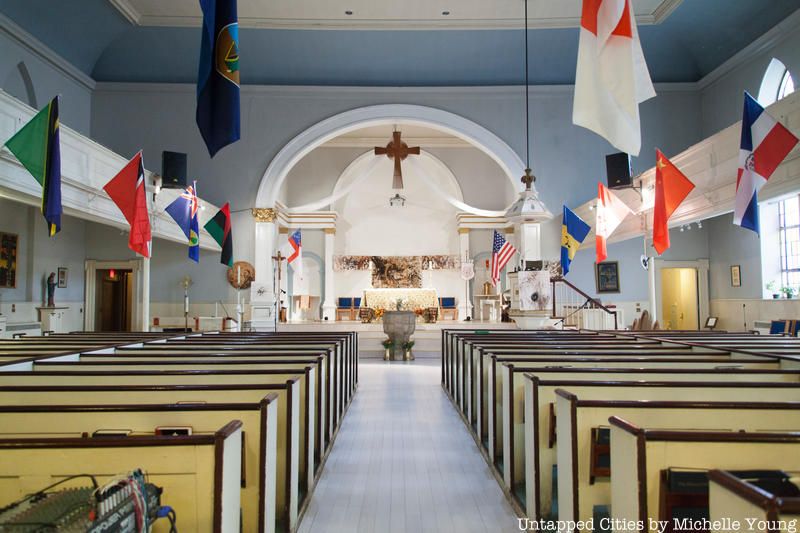
The entire church was segregated based on different classifications and clearly compartmentalized. Walking down the aisle of pews you notice that those in front are wider and get progressively more narrow towards the back of the church. This is because the wealthiest of the congregation could pay for the best seats, up front. The wealthy merchants and their families would not want to sit in the same section as free blacks, those who paid taxes and owned land, or indentured servants, who were relegated to the back of the church and the upper balconies.
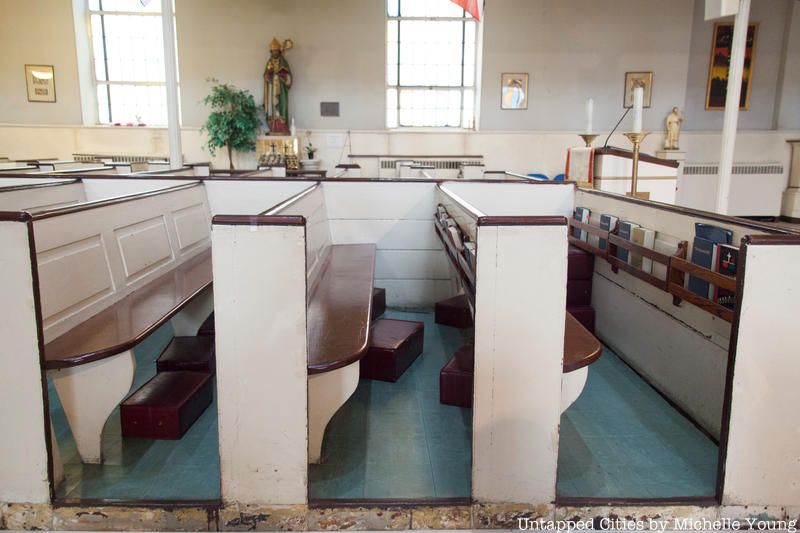
The pews are widest in the front, and get progressively narrower
Since slavery was abolished in New York State in 1827, there has been debate over who exactly sat in the “slave galleries.” According to The St. Augustine’s Project, a primarily volunteer run non-profit responsible for the restoration and preservation of the galleries, articles and church records show that the rooms were referred to as “slave galleries” and associated with the African American community. The church was designed in the early 1820s when slavery was still legal, so as the Reverend Errol Harvey, Rector of St. Augustine’s Church noted, “Maybe they didn’t believe slavery was going to end.” Even though the law which abolished slavery in the state went into effect 1827, the actual enforcement of abolition was a long process. The last slaves in New York were freed in 1841. Those sitting in the galleries were very likely slaves and possibly indentured servants or free blacks treated with prejudice by New York Jim Crow laws.
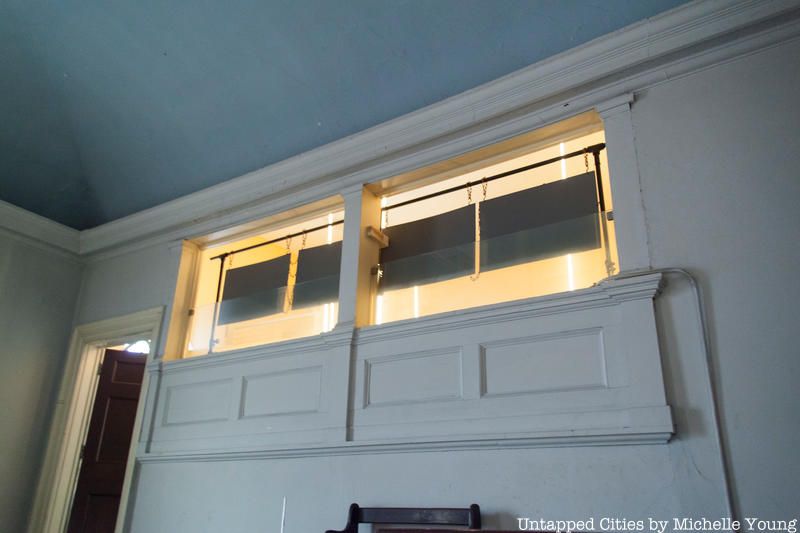
View of the other slave gallery from the back of the sanctuary’s second floor
While we usually associate slavery and Jim Crow with the South, the practices, prejudice and segregation that came with it were prevalent in the North and New York City as well. Today, St. Augustine’s is working to acknowledge the church’s role in that history and grapple with its legacy. How the other 1/2 lives, an art installation inside the galleries by Denzel Russell, uses lights, glass, and a low rumbling music to call attention to the place where Black New Yorkers were meant to not be seen or heard. The piece was created as part of the Revision Suite, an event at the church that brought together a group of artists, writers, and musicians “to meditate on the architectural history of its ‘slave galleries’ and to explore their own connections to worship and spiritual labor.” How the other 1/2 lives calls for viewers to reflect on the marginalization of 19th century Black New Yorkers and “approach these spaces with reverence and appreciation for the spirits who occupy them.”
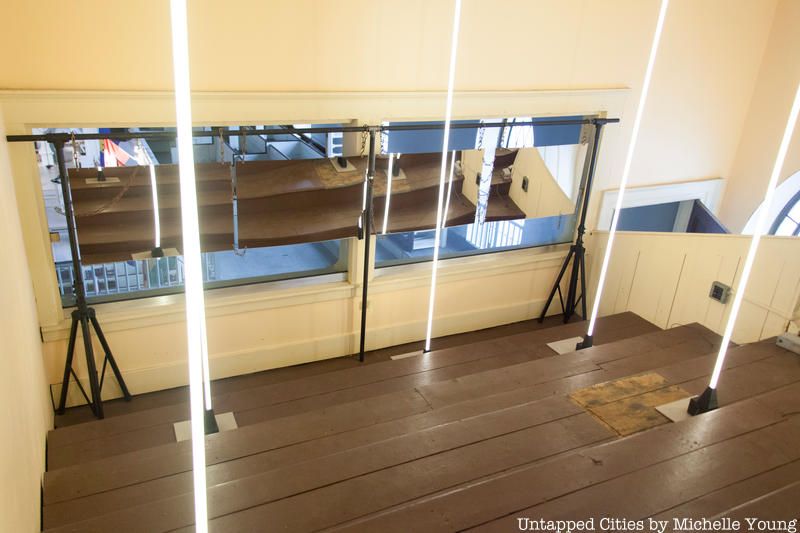
The second slave gallery has been restored, though shadow boxes remain on the walls and steps to give indication of the original materials
St. Augustine’s, the oldest church in the Lower East Side and the oldest building on its block, is one of the very few churches in the entire country to retain its slave galleries and furthermore work to reconcile the pain of their past. Today, as the church celebrates its 190th anniversary, The St. Augustine Project continues to research, preserve, and interpret the slave galleries and educate the public on the legacy of the neighborhood’s African American communities.
If you are an Untapped Cities Insider, you can join us for a special tour of St. Augustine’s Episcopal Church and the slave galleries on February 23rd. Not an Insider yet? Become a member today to gain access to free behind-the-scenes tours and special New York City events all year long!
[mepr-show if=”rule: 518547″][uc_booking_button title=’Book Now’][/mepr-show][mepr-hide if=”rule: 518545″][uc_insider_button title=’BECOME A MEMBER TO JOIN THIS TOUR FOR FREE!’ url=’/plans/insiders/’][/mepr-hide][mepr-show if=”rule: 518546″][uc_insider_button title=’UPGRADE YOUR MEMBERSHIP TO JOIN THIS TOUR FOR FREE!’ url=’/plans/insiders’][/mepr-show]
Next, check out The Top 10 Secrets of NYC’s Former Slave Market on Wall Street and
Subscribe to our newsletter